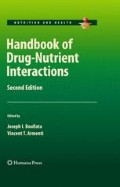Objectives
• Understand the impact of nutritional status on the growth and development of pediatric patients.
• Identify common interactions between drugs and nutrients and dietary supplements and nutrients, including vitamins.
• Discuss ways to manage medications to avoid interactions.
Access this chapter
Tax calculation will be finalised at checkout
Purchases are for personal use only
References
Maka DA, Murphy LK. Drug–nutrient interactions: a review. AACN Clinical Issues 2000;11(4):580–589.
Skyscape. PediatricDrugs™, version 3.1.3.
Lacy, CF, Armstrong, LL, Goldman, MP, Lance, LL. Ciprofloxacin. In: Drug Information Handbook, 14th ed., Hudson: Lexi-Comp, Inc., 2006–2007:345–349.
Santos CA, Boullata JI. An approach to evaluating drug–nutrient interactions. Pharmacotherapy 2005;25:1789–1800.
Samour PQ, King K, eds. Physical Growth and Maturation. In: Handbook of Pediatric Nutrition, 2nd ed. Sudbury MA: Jones and Bartlett Publishers, 2005:1–10.
Fomon SJ, Haschke F, et al. Body composition of Reference children from birth to age 10 years. Am J Clin Nutr 1982;35:1169.
Samour PQ, King K, eds. Growth Failure. In: Handbook of Pediatric Nutrition, 2nd ed. Sudbury MA: Jones and Bartlett Publishers, 2005:391–406.
Institute of Medicine of the National Academies. Preventing Childhood Obesity: Health in the Balance. Washington, DC: The National Academies Press, 2005:79–115.
Barlow SE and the Expert Committee. Expert committee recommendations regarding the prevention, assessment, and treatment of child and adolescent overweight and obesity: summary report. Pediatrics 2007;120(suppl 4):S164–S192.
de Onis M, Onyango AW, Borghi E, Siyam A, Nishida C, Siekmann J. Development of a WHO growth reference for school-aged children and adolescents. Bull WHO, 2007;85:660–667.
Food and Agriculture Organization of the United nations/World Health Organization/United Nations University. Human Energy Requirements. Report of a Joint FAO/WHO/UNU Expert Consultation, FAO Food and Nutrition Technical Report Series 1, Chapter 3 and Chapter 4 Rome Italy, 2004.
Institute of Medicine of the National Academies. Dietary Reference Intakes for Energy Carbohydrate, Fiber, Fat, Fatty Acids, Cholesterol, Protein, and Amino Acids (Macronutrients). Washington, DC: National Academies Press, 2002/2005 www.nap.edu.
Stone B. Fluid and Electrolytes. In The Harriet Lane Handbook, 17th ed. Philadelphia, PA: Mosby Year Book, 2005:284.
Quercia RN, Fan C, Liu X, Chow MSS. Stability of omeprazole in an extemporaneously prepared oral liquid. Am J Hosp Pharm 1997;54:1833–1836.
Marvel ME, Bertino JS. Comparative effects of an elemental and a complex enteral feeding formulation on the absorption of phenytoin suspension. J Parent Enteral Nutr 1991;15:316–318.
Doak KK, Haas CI, Dunnigan KJ, et al. Bioavailability of phenytoin acid and phenytoin sodium with enteral feedings. Pharmacotherapy 1998;18:637–645.
Segal S, Kaminski S. Drug–nutrient interactions. Am Druggist 1996;213:42–49.
Harder S, Fuhr U, Beermann D. Ciprofloxacin absorption in different regions of the human gastrointestinal tract. Br J Clin Pharmacology 1990;30:35–39.
Kirk J. Significant drug–nutrient interactions. Am Fam Physician 1995;51:1175–1182.
McEvoy GK, ed. Macrolides. In: American Hospital Formulary Service Drug Information 2006. Bethesda: American Society of Health-System Pharmacists, 2006:216–264.
McEvoy GK, ed. Quinolones. In: American Hospital Formulary Service Drug Information. Bethesda: American Society of Health-System Pharmacists, 2006:364–422.
Lacy CF, et al., eds. Nitrofurantoin. In: Drug Information Handbook. Hudson: Lexi-Comp, 2006–2007:1143–1144.
Lacy CF, et al, eds. Griseofulvin. In: Drug Information Handbook. Hudson: Lexi-Comp, 2006–2007:750–751.
Edwards DJ, Zarowitz BJ, Slaughter RL. Theophylline. In: Evans WE, Schentag JJ, Jusko WJ, eds. Applied Pharmacokinetics: Principles of Therapeutic Drug Monitoring, 3rd ed. Vancouver: Applied Therapeutics, Inc.; Chapter 13, 1992.
Winter ME. Theophylline. In: Koda-Kimble MA, Young LY, eds. Basic Clinical Pharmacokinetics, 3rd ed. Vancouver: Applied Therapeutics, Inc., 1994:405–445.
Koda-Kimble M, Young LY, eds. Thrombosis. Applied therapeutics the Clinical use of Drugs, 7th ed. Baltimore: Lippincott Williams and Wilkins; Chapter 14, 2001.
Taketomo CK, Hodding JH, Kraus DM, eds. Methylphenidate. Pediatric Dosage Handbook, 13th ed. Hudson: Lexi-Comp, 2006–2007:927–931.
McEvoy GK, et al, eds. Antihistamine Drugs. American Hospital Formulary Service Drug Information. Bethesda: American Society of Health-System Pharmacists, 2006:1–4.
Ang-Lee MK, Moss J, Yaun C. Herbal medicines and perioperative care. JAMA July 2001;286(2):208–216.
Cheng, TO. Herbal interactions with cardiac drugs. Arch Intern Med 2000 March 27;160(6):870–871.
Forget L, Goldroses J, Hart JA, Hyun T, Meacham D, Tyler T, Wisneski LA, eds. Chromium. In: Herbal Companion to AHFS DI 2001. Bethesda: American Society of Health-System Pharmacists, 2001:123–124.
Valli G, Giardina EV. Benefits, adverse effects and drug interactions of herbal therapies with cardiovascular effects. J Am Coll Cardiol 2002;39:1083–1095.
Lacy CF, et al, eds. Vitamin A. In Drug Information Handbook 2006–2007. Hudson: Lexi-Comp, 2006–2007:1661–1662.
McEvoy GK, ed. Vitamin B complex. In: American Hospital Formulary Service Drug Information. Bethesda: American Society of Health-System Pharmacists, 2006:3556–3568.
McEvoy GK, ed. Calcium salts. In: American Hospital Formulary Service Drug Information. Bethesda: American Society of Health-System Pharmacists, 2006:2601–2607.
Taketomo CK, Hodding JH, Kraus D, eds. Calcium Supplements. In: Pediatric Dosage Handbook, 13th ed. Hudson: Lexi-Comp Inc., 2006–2007:240–244.
Taketomo CK, et al, eds. Folic acid. In: Pediatric Dosage Handbook, 13th ed. Hudson: Lexi-Comp., 2006–2007:629–630.
McEvoy GK, ed. Iron preparations. In: American Hospital Formulary Service Drug Information. Bethesda: American Society of Health-System Pharmacists, 2006:1418–1433.
McEvoy GK, ed. Antacids. In: American Hospital Formulary Service Drug Information 2006. Bethesda: American Society of Health-System Pharmacists, 2006:2853–2858.
Taketomo CK, Hodding JH, Kraus D, eds. Magnesium Supplements. In: Pediatric Dosage Handbook, 13th ed. Hudson: Lexi-Comp Inc., 2006–2007:876–880.
Taketoma CK, Hodding JH, Kraus D, eds. Zinc Supplements. In: Pediatric Dosage Handbook, 13th ed. Hudson: Lexi-Comp Inc., 2006–2007:1464–1465.
Gauthier I, Malone M, Lesar T, Armovitch S. Comparison of programs for preventing drug nutrient interactions in hospitalised patients. Am J Health Syst Pharmacy 1997;54(4):405–411.
Nowlin DB. Refining a food–drug interaction program. Am J Health Syst Pharmacy 1998;55(2):114–122.
Author information
Authors and Affiliations
Editor information
Editors and Affiliations
Rights and permissions
Copyright information
© 2009 Humana Press, a part of Springer Science+Business Media, LLC
About this chapter
Cite this chapter
Kotzer, L.M., Mascarenhas, M.R., Wallace, E. (2009). Drug–Nutrient Interactions in Infancy and Childhood. In: Boullata, J., Armenti, V. (eds) Handbook of Drug-Nutrient Interactions. Nutrition and Health. Humana Press. https://doi.org/10.1007/978-1-60327-362-6_20
Download citation
DOI: https://doi.org/10.1007/978-1-60327-362-6_20
Published:
Publisher Name: Humana Press
Print ISBN: 978-1-60327-363-3
Online ISBN: 978-1-60327-362-6
eBook Packages: MedicineMedicine (R0)

